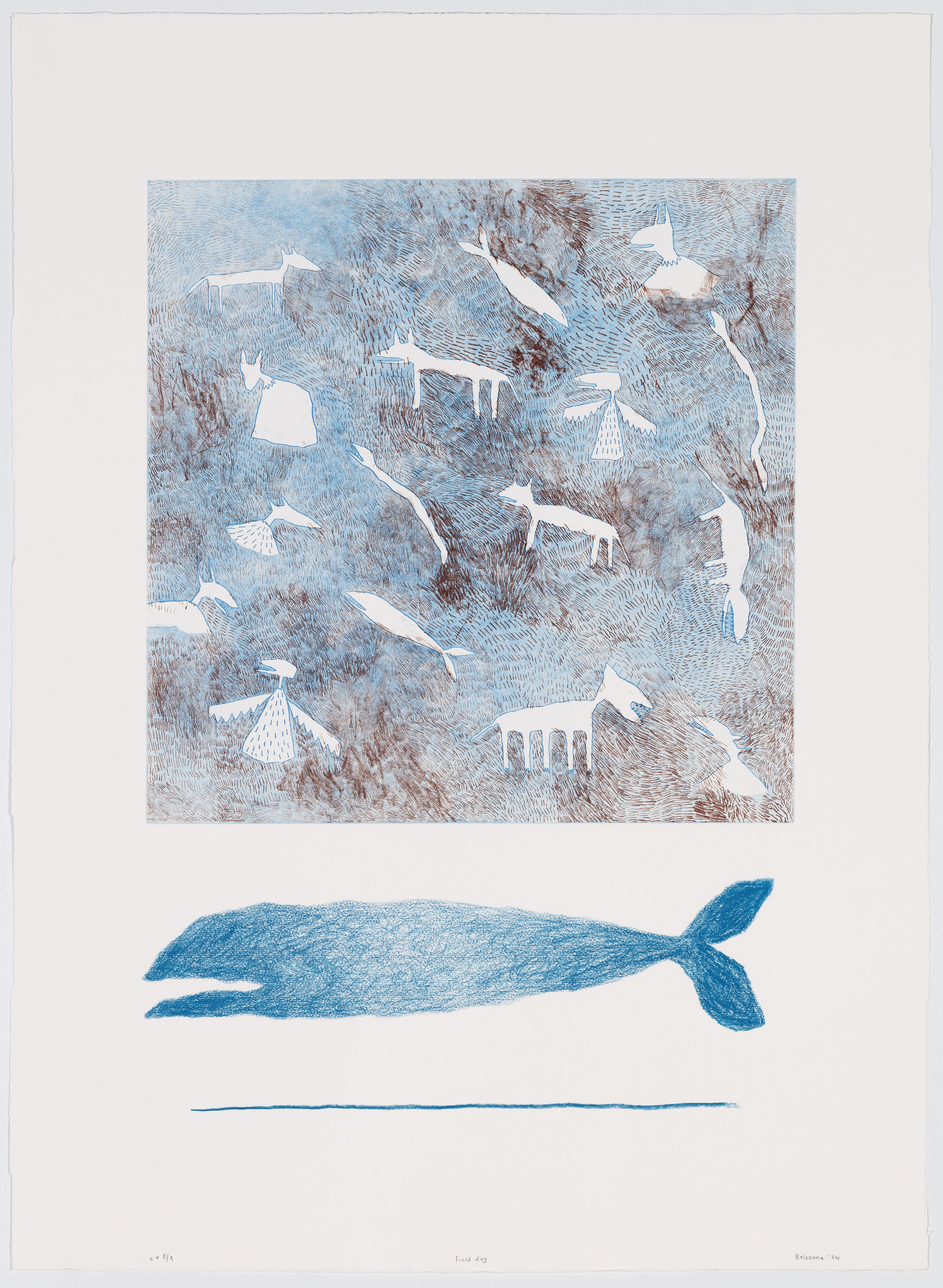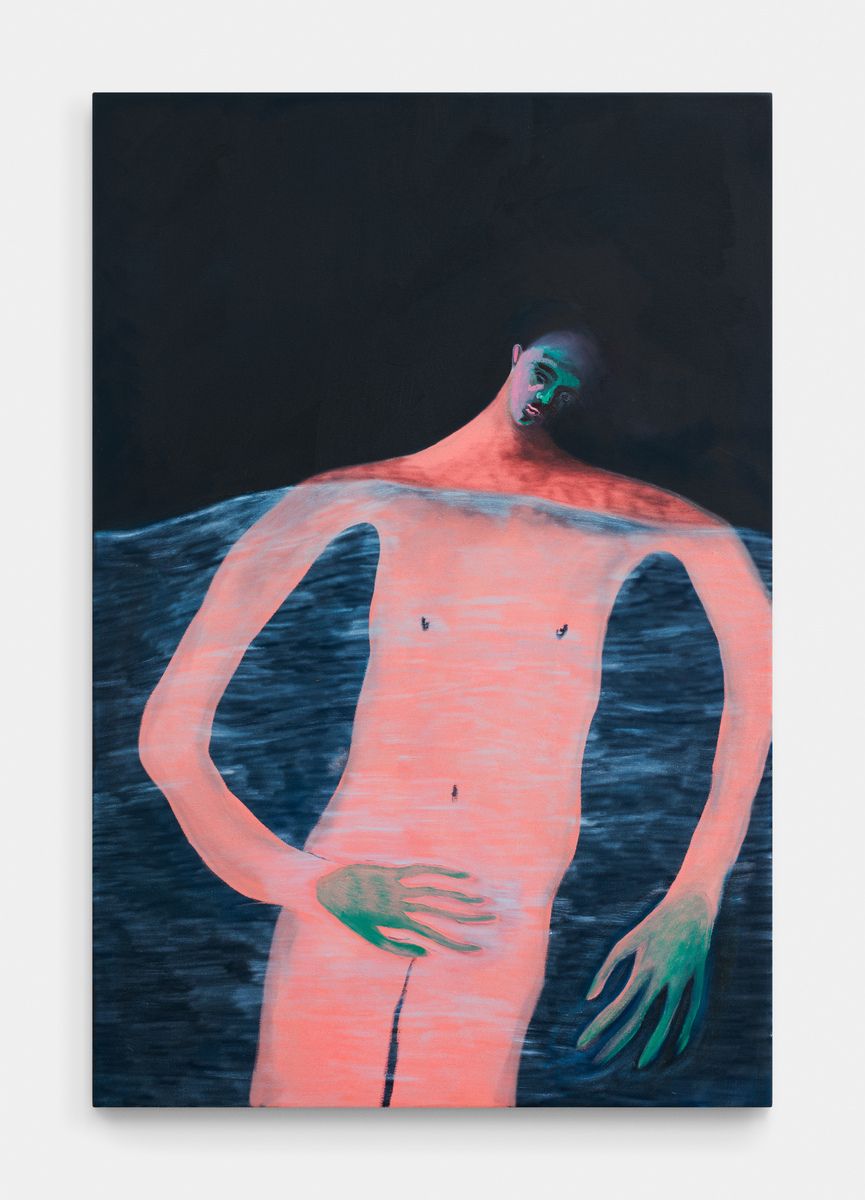Strangeness and Charm
By Donatella du Plessis
-----------
“The beautiful is always bizarre,” says Baudelaire in his Curiosités esthétiques. “I do not mean that it should be deliberately, coldly bizarre, for in this case it would be a monster gone off the rails of life.” While this year’s RMB Latitudes Art Fair went ahead without any overt insanity of the kind that Baudelaire describes, many of the works on display exemplified the strangeness and charm of the beautiful bizarre in a venue so splendidly unorthodox that one might be forgiven for thinking it was designed for the very purpose.

Balekane Legoabe, field day 8/9, 2024, variable colour etching with unique drawn element, 77x56,5cm, CONTACT TO BUY
Some of the most striking strangeness to be found at the fair were Dominic Pretorius’ three glass funerary urns, presented by Vela Projects. Notwithstanding the enthralling grotesqueness of the urns’ ceramic human inhabitants, the works are also mounted in aluminium light boxes, the stark white glow making them seem all the more strange and otherworldly.
Each of Pretorius’ light boxes has been named for a line from Inferno, the first part of Dante Alighieri's The Divine Comedy, and while the connection to the grandeur of that work is no disadvantage, Pretorius’ approach to it is both refreshing and original. Rather than presenting the viewer with the highlights package of the circles of hell so common in popular culture, Pretorius is inspired by the first three canti of the Inferno; the wandering in a dark wood and the descent to the gate of hell.
In ‘Through me you go to the grief-racked city’, the viewer is met with a wall of terrified faces. The souls waiting at the gate of hell are reduced to identical heads and shoulders, packed together like a chaotic, writhing catacomb wall, eyes and mouths wide open, the clay cracking and fragmented. The sense of claustrophobia is only augmented by the startling presentation of these faces inside a glass urn: locked in, imprisoned in a lake of baked clay.
With the light box a cruel spotlight on their inability to escape, the work is a visceral portrayal of the horrors of liminality. What lies beyond the gate is hideous, but the act of waiting for it, imagining it, with the words “Through me you go to the grief-wrecked city” inscribed above, is a torture that can only be relieved by entering hell itself. Pretorius, unlike Dante, is merciless in this regard.

Dominic Pretorius, Down where the sun is mute II, R40,000.00 ex. VAT, CONTACT TO BUY
Balekane Legoabe’s captivating series of etchings and monotypes (presented by Eleven Editions) are far closer to the charming end of what we might call the strangeness and charm spectrum. Liminality and the experiences of the living things that pass through it are a central concern for Legoabe, and the influence of San Rock Art in her work imbues it with the primal energy of caves, some of the oldest liminal spaces in existence.
In ‘Field Day 8/9’, a rectangular sheet of pristine paper serves as a cave wall. It is dominated by an etching of a tranquil, pale blue square swirling with meticulously detailed earthen pathways. This square gives form to the otherworldly creatures that exist on the surface of the cave wall. The animals, all presented in profile in the manner of San Rock Art, are like characters from a half-remembered dream or sketches from the notebook of an impish archeologist. Dogs with five legs and foxes with three – or the other way round, or neither – frolic alongside birds and goats that have no visible legs at all, their bottom halves enrobed in what look like little dresses or miniature caparisons. The effect is riotous and fantastical, but playful at the same time. Indeed, if one considers ‘Field Day 8/9’ in the context of cave art, it is hard to avoid reimagining this whimsical work as part of the Cradle of Humankind, enchanting all the people that move through the caves over the centuries.
Beneath the blue square and its menagerie of charming beasts is a blue whale. It is clearly outside the borders of the square, but measures exactly the same length, with a line etched directly beneath the whale as though to emphasise its existence above and apart from the rest of the world. The world’s largest mammal, the blue whale rules the ocean and the element of water, which with all its attendant symbolism of transcendence, death and rebirth, is an archetypal liminal space of which the whale is the ultimate representation. Thus, Legoabe portrays two grand forces of nature and liminality (Earth and Water) in a way that is both unusual and delightful, typifying the beauty of the bizarre and unconventional.
Of all the artworks at the fair, strangeness and charm are both deployed to luminous effect in Anico Mostert’s painting ‘Moon Shadows’ (oil on board, presented by Ebony/Curated). White light shines from an incandescent moon, spiralling through the indigo expanse like soundwaves. Below is a green planet, bathed in moonlight. On the surface, four faceless, elongated figures stop to listen. None of them is craning their heads to the sky, and yet they seem to be rendered larger by whatever it is that they hear. The facelessness of Mostert’s figures gives a touching universality to this communal act of listening. The moonlight and the moon music create a conduit, an in-between space, in which humanity can achieve and be enriched by a transcendent connection with the divine, or nature, or whichever primal forces shape our lives here on earth.

Anico Mostert, Moon Shadows, 2023
An important part of what makes Mostert’s work so enthralling is her use of colour. In art, communion with the divine can and has been portrayed in countless, exceedingly traditional ways, many involving blood red, snow white, gold leaf, ultramarine blue or ascetic brown and black. Mostert, however, has clad her figures in robes of pale pink, that most feminine and whimsical of colours, thus bringing a sense of modernity, gentleness and love to an age-old subject that is all too often clouded by fear. The contrast of the pink robes with the dark drama of the background creates a scene of uncanny, resplendent magic.

Anico Mostert, Swim, 2023, Price on request, CONTACT TO BUY
Observing these portrayals of liminal worlds in a place like Shepstone Gardens, where moving from Renaissance Italy to Ottoman Turkey is possible by climbing a flight of stairs, crossing a pool or dodging the odd gorgoneion, is bizarre in itself. One rushes from one solid-seeming universe to another, drunk on splendour and whimsy. Then, the uncanny sets in, and one is seized by feelings of being between one place and another, unable to go forwards or backwards no matter how much one moves. The artworks and the venue work together to immerse the viewer in a remarkable, liminal world, and the experience is extraordinary.
This article was produced as part of the ARAK x Latitudes Critical Art Writing Workshop led by Ashraf Jamal over the course of the 2024 RMB Latitudes Art Fair.
Further Reading In Articles
African Artist Directory















